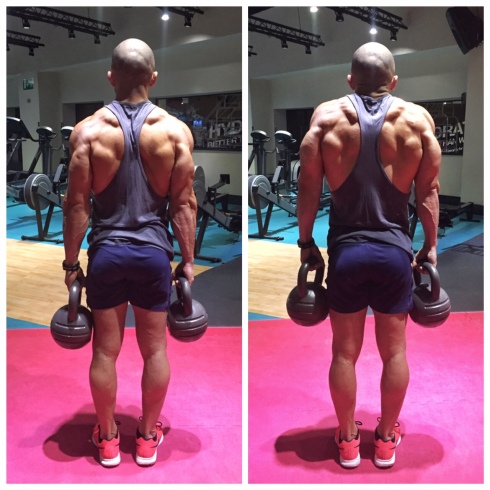A Haphazard Approach to Weight Training Creates Physical Problems
Muscle imbalances occur when specific muscles become over stimulated into excessive growth while opposing muscles receive negligible stimulation—the result of which may be chronic pain, an uneven posture and aches in other areas of the body. In order to avoid shoulder/trapezius imbalance, you must first understand the functionality of the shoulders and trapezius; then they should be worked together as a unit often and evenly.
A cardinal foul-up made by most weight training enthusiasts is to overwork the arms and chest—referred to as beach muscles in bodybuilding circles—while ignoring the shoulders and trapezius muscles. Adjacent to the chest is the shoulder, which is a three headed muscle also known as the deltoid. Deltoids have an anterior, medial and posterior side.
The trapezius or “traps” are the highly visible group of muscles located at the base of the neck and stretching into the middle of the back. Traps consist of an upper and middle region. Underdeveloped shoulders and traps create symmetrical imbalances that could lead to injuries because underdeveloped muscles tend to be weaker, less flexible and less functional.
There are many strategies available to improve lagging shoulders and traps, but simple exercise routines that can be done quickly with minimal equipment provide ample muscular growth and recovery time. The routine outlined below can be completed in twenty minutes or less and it can quickly correct imbalance issues.
The equipment needed includes a cable pulley, barbell and dumbbell. The weights used should be heavy enough to maintain strict form throughout each movement. Do not over do it and thoroughly warm up before lifting.

A Quick Routine
Prepare to complete 12 total sets of single arm/trapezius movements. Raise the weights in a deliberate, controlled fashion. Perform each exercise using a fluid motion and a count of four seconds to raise the weight and four seconds to lower it. The amount of weight used should be heavy enough to grind out the last repetition of each exercise.
Exercise 1 is the one-arm cable lateral raise. Lift the weight by raising the cable handle parallel to the floor for 10 repetitions with one arm. Switch arms and repeat. When descending the cable should not rest on the body because doing so reduces tension. Keep tension on the working muscle by stopping the movement about 6 inches away from the body. Perform 3 sets of 10 – 12 repetitions alternating each arm until completion. Rest takes place in unused arm while working opposite arm. If properly executed, muscle fibers in shoulders and traps will be burning!
Exercise 2 is the one-arm bent over cable lateral raise. Bend forward approximately 75 degrees at the waist keeping knees slightly bent. The mechanics of exercise 2 is similar to exercise 1. Remember while in the bent-over position avoid injury by not twisting the lower back during the movement. The exercise should be done briskly and with lighter weight than used in exercise 1.
Exercise 3 is the two arm cable upright row. Attach a straight bar to the low pulley. Select a weight that allows you to grind out 12 repetitions. Take several small steps back until the distance from the pulley creates slight tension on your trapezius. Slowly pull the bar to shoulder height while briefly squeezing the traps. Keep elbows up and then slowly descend. Do not allow weight to touch the stack; maintain tension on the target muscle. Repeat for 3 sets. When raising the weight, it is unnecessary to pull the bar above shoulder height. Rest no more than 2 minutes between sets.
Exercise 4 is barbell front raises. Load a barbell with enough weight to do 10 repetitions. Maintain strict form and do not hyper extend the back by leaning backwards. Complete 2 sets with rest periods approximately 60 seconds between sets.
Exercise 5 is the dumbbell shrug. This movement consists of a higher repetition count to torch the shoulder and traps musculature. Perform 1 set of 50 repetitions. Pick a moderately heavy weight that does not impede proper form and grind out reps without removing the ‘bells from your hands. Extend the set if needed to reach the 50 count before releasing grip from the dumbbells. This movement is a burner and it also helps speed the removal of muscle waste such as lactic acid.
Remember to do cool down stretches for several minutes after the workout. Using this mini-program regularly combined with determination, patience and hard work will spur shoulder/trap growth and add balance to a lagging physique.

Traps and shoulders were my favorite muscles to workout out at the gym
This is good to know thanks